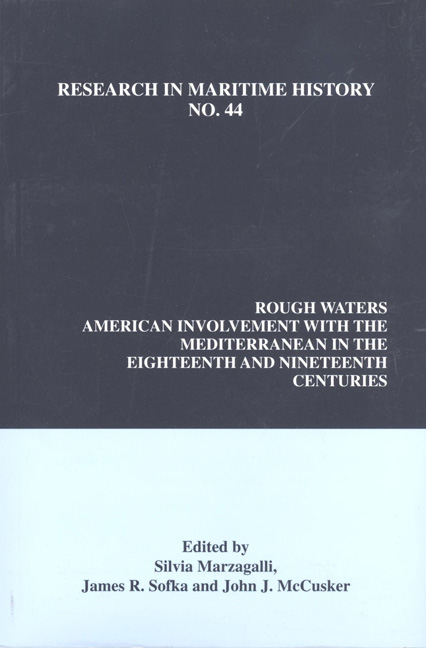Book contents
- Frontmatter
- Contents
- About the Editors
- Contributors' Notes
- “Rough Waters: American Involvement in the Mediterranean in the Eighteenth and Nineteenth Centuries: An Introduction”
- “Worth a War? The Importance of the Trade between British America and the Mediterranean”
- “Relations between North America and the Italian Peninsula, 1763-1799: Tuscany, Genoa and Naples”
- “American Shipping into the Mediterranean during the French Wars: A First Approach”
- “Notes toward a Franco-American Mediterranean 'From Below'”
- “Consuls and Consiglieri: United States Relations with the Italian States, 1790-1815”
- “Old and New Republics: Diplomatic Relations between the Republic of Genoa and the United States of America”
- ‘“From the Halls of Montesuma, to the Shores of Tripoli:’ Antoine Zuchet and the First Barbary War, 1801-1805”
- “Minorca: The First United States Naval Base in the Mediterranean and the American Consulate at Port Mahon”
- “‘The Jeffersonian Idea of National Security’ Revisited”
- “The Reluctant Warrior: Thomas Jefferson and the Tripolitan War, 1801-1805”
- “Slavery as Social Mobility? Western Slaves in Late Eighteenth Century Algiers”
- “Americans in the Mediterranean in the Late Eighteenth and Early Nineteenth Centuries: Concluding Remarks”
“Minorca: The First United States Naval Base in the Mediterranean and the American Consulate at Port Mahon”
- Frontmatter
- Contents
- About the Editors
- Contributors' Notes
- “Rough Waters: American Involvement in the Mediterranean in the Eighteenth and Nineteenth Centuries: An Introduction”
- “Worth a War? The Importance of the Trade between British America and the Mediterranean”
- “Relations between North America and the Italian Peninsula, 1763-1799: Tuscany, Genoa and Naples”
- “American Shipping into the Mediterranean during the French Wars: A First Approach”
- “Notes toward a Franco-American Mediterranean 'From Below'”
- “Consuls and Consiglieri: United States Relations with the Italian States, 1790-1815”
- “Old and New Republics: Diplomatic Relations between the Republic of Genoa and the United States of America”
- ‘“From the Halls of Montesuma, to the Shores of Tripoli:’ Antoine Zuchet and the First Barbary War, 1801-1805”
- “Minorca: The First United States Naval Base in the Mediterranean and the American Consulate at Port Mahon”
- “‘The Jeffersonian Idea of National Security’ Revisited”
- “The Reluctant Warrior: Thomas Jefferson and the Tripolitan War, 1801-1805”
- “Slavery as Social Mobility? Western Slaves in Late Eighteenth Century Algiers”
- “Americans in the Mediterranean in the Late Eighteenth and Early Nineteenth Centuries: Concluding Remarks”
Summary
Introduction
The port of Mahón on the island of Minorca was the first official American naval base in the Mediterranean. Its great natural harbour and strategic position in the western Mediterranean early attracted American attention. As a result, the relationship between Minorca and the United States was intense in the nineteenth century, especially until 1876 after which the American consulate at Mahón lost much of its importance. This essay will analyze four basic aspects of this relationship. First, we will present a synthesis of the historical evolution of Minorca in the eighteenth and nineteenth centuries to contextualize the reasons for American interest. Second, we will look at the United States consulate in Mahón and its functions. Next, we will examine the role of the port of Mahón as an American naval base. Finally, we will evaluate the social, economic, ideological and cultural influence of the American naval presence on the island. Although some works have been written on this subject, the American presence in Minorca is almost unknown in Spain and even on the island itself. Indeed, with the notable exception of Admiral Farragut, who is well known, especially in the town of Ciutadella where he is regarded as an illustrious son, the American role has faded into the mists of history.
Minorca and Port Mahon until 1850
Minorca is located in the centre of the western Mediterranean at the intersection of maritime routes between Spain and Italy, on one hand, and France and Algeria on the other. It has an area of 700 square kilometres and had a population of about 31,000 in 1800. The value of the island lies in the great natural harbour of Mahón, considered one of the best in the Mediterranean. Early American visitors lauded the harbour's virtues. Walter Colton, for example, in 1851 provided a very eloquent description of the security of the port:
This harbour cuts its narrow way between bold and broken shores for several miles into the island; affording through its whole length a most secure anchorage…Nothing can surpass the sentiment of quietude and security which one feels riding here at anchor, while the chafing ocean is fretting against the rocky barrier without. […]
- Type
- Chapter
- Information
- Rough WatersAmerican Involvement with the Mediterranean in the Eighteenth and Nineteenth Centuries, pp. 135 - 160Publisher: Liverpool University PressPrint publication year: 2010

